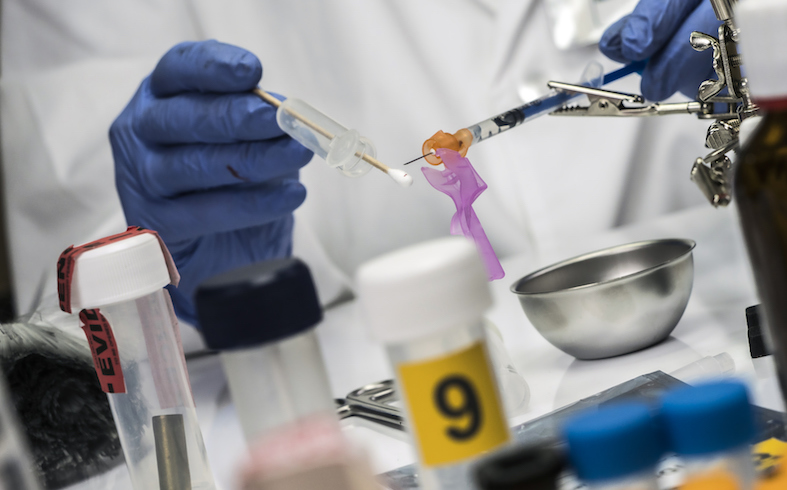
Rapid DNA technology expands law enforcement’s ability to test samples, but also raises privacy concerns.
DNA testing on TV shows always looks fast and easy. Hardworking investigators manage to get saliva or a blood sample from a suspect, and a short time later they know whether they caught the killer. In reality, the process has seldom worked so quickly. But thanks to a federal law adopted two years ago that has now taken effect, real life may start to mirror television.
The Rapid DNA Act of 2017 instructs the Federal Bureau of Investigation (FBI) to establish standards for Rapid DNA machines so that federal, state, and local police departments can upload results from these machines to a federal database of DNA samples. Although this will expand law enforcement’s ability to analyze and use DNA profiles, the rapid DNA system could exacerbate existing flaws in DNA analysis that disproportionately affect people of color and put innocent people at risk of prosecution based on their DNA.
The Rapid DNA technology that prompted the Act uses the same basic method that scientists in accredited crime labs have traditionally employed, with one key difference: it works by machine. Rapid DNA “carries out a fully automated process” so that after a sample is placed in the instrument, it produces a completed analysis less than two hours later.
One county in Pennsylvania has used Rapid DNA technology to decrease the amount of time it takes to perform DNA analysis compared to sending samples to a lab, which can take up to several days to complete the analysis. The National Association of Police Organizations has praised the Rapid DNA for its efficiency, saying that the law “allows law enforcement to keep pace, strengthening our ability to safeguard our communities.”
In addition to cutting down the time necessary for testing dramatically, Rapid DNA reduces the risk of contamination during analysis. Obtaining a DNA profile from a sample requires several steps to extract DNA from cells and then to amplify and process the DNA so that a computer can read the results. Traditionally, an analyst had to perform each of these steps by hand, creating the risk that analysts would accidentally introduce their own DNA. Because Rapid DNA removes human involvement after insertion of the sample, it reduces the risk of contamination during the analysis process.
Because a person does not need any special knowledge of DNA analysis to operate a Rapid DNA instrument, however, the FBI has limited the circumstances in which law enforcement can use this technology in an effort to prevent its use in situations where samples are not appropriate for the technology.
Since the creation of the nationwide database of DNA profiles—known as the Combined DNA Index System (CODIS)—the FBI has set quality assurance and proficiency standards which labs must comply with to become accredited to upload or search DNA profiles in the national database. Following the passage of the Rapid DNA Act, the FBI also established prerequisites that law enforcement booking agencies must meet to use Rapid DNA to create profiles to upload to CODIS.
The FBI specifies that only DNA samples from known individuals, not crime scene samples, can be analyzed with Rapid DNA systems in booking stations. DNA analyses of forensic samples from crime scenes, which can be degraded and often contain the DNA of multiple people, require subjective judgment by analysts; however, expert judgment is not as critical when analyzing a cheek swab from a recently arrested suspect.
Because of this distinction, the National District Attorney Association strongly supports restricting the use of Rapid DNA technology for analyzing samples from known arrestees. The Association emphasizes that this support only extends to samples of known individuals, not forensic samples from crime scenes, due to concern that use of this technology on crime scene DNA would potentially prevent prosecutors from using the evidence in court. Rapid DNA testing could physically destroy valuable samples being analyzed—making it impossible to retest them with other means—and even if standard DNA testing is subsequently performed, inaccurate results could cause a jury to question the validity of the standard DNA testing.
Yet one legal scholar has reportedly expressed concern that, even if Rapid DNA testing is limited to known individuals, it could lead to undesirable policing practices.
Erin Murphy—a professor whose book Inside the Cell explains the potential fallibility of DNA analysis—has reportedly questioned the wisdom of testing the DNA of anyone a police department arrests. She says that such usage changes the “fundamental way we’ve structured liberty in our constitutional order.” In response to reports that police departments may seek suspects’ consent to test them prior to arrest, Murphy reportedly worries that such a practice will only “exacerbate racial biases in the criminal justice system” since minorities can be seen as suspicious when engaging in normal everyday activities.
At present, however, if state law allows police officers to collect DNA from people upon their arrest, then the Constitution does not give them the ability to refuse a cheek swab. In the case Maryland v. King, a narrow majority of the Supreme Court rejected a plaintiff’s argument that DNA collection constitutes an unreasonable search and seizure prohibited by the Fourth Amendment, holding that when probable cause supports an arrest, analysis of a cheek swab is an acceptable booking procedure.
Routine DNA testing upon arrest will have the benefit of increasing the number of profiles in CODIS—and therefore of increasing the chance that the database will return a match when searched—but increasing the number of searches also increases the chances of innocent people being implicated in a crime by their DNA.
For instance, in one recent case, investigators found the DNA of an innocent man on a murder victim. When they realized he had an iron-clad alibi, the investigators eventually discovered that the man’s DNA ended up on the scene because the same paramedics who treated him earlier in the day also examined the murder victim and transferred so-called “touch DNA” onto the victim’s body.
False matches can also occur as a result of misleading statistics. Because DNA profiles contained in CODIS only focus on a few designated places in the human genome, matches can occur in the database even though the original samples came from different people.
In a case where the likelihood of a random match is 1 in 200,000 people, for example, a search of a database containing DNA from 1 million people would be predicted to yield five matches. The probability of finding a unique profile may not suffice to identify a single suspect when considered in conjunction with the size of the database.



